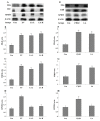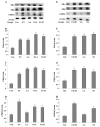2-Phenylacetamide Isolated from the Seeds of Lepidium apetalum and Its Estrogen-Like Effects In Vitro and In Vivo
- PMID: 30205508
- PMCID: PMC6225176
- DOI: 10.3390/molecules23092293
2-Phenylacetamide Isolated from the Seeds of Lepidium apetalum and Its Estrogen-Like Effects In Vitro and In Vivo
Abstract
The aim of this study was to investigate the estrogen-like effects of 2-phenylacetamide (PA), which is the main compound isolated from the seeds of Lepidium apetalum Willd (LA). Results showed that LA and PA could promote the proliferation of MCF-7 cells. The mouse uterine weight test showed that, LA and PA could increase the uterus index of immature female mice, and the levels of luteinizing hormone (LH) and estrogen (E2). LA could increase the expression of ERα and ERβ, while PA could increase the expression of ERα, ERβ and GPR30 in the uterus and MCF-7 cells. In addition, co-incubation of the estrogen receptor blocker with LA or PA abolished the inductive effect of the proliferation. PA has estrogenic activities and was the material basis of LA that played the estrogenic effect. LA and PA might be used for the treatment of perimenopause syndrome in a novel application.
Keywords: 2-phenylacetamide; ERα; ERβ; GPR30; Lepidium apetalum Willd; estrogen-like effects.
Conflict of interest statement
The authors declare no conflicts of interest.
Figures








Similar articles
-
Uridine derivatives from the seeds of Lepidium apetalum Willd. and their estrogenic effects.Phytochemistry. 2018 Nov;155:45-52. doi: 10.1016/j.phytochem.2018.07.013. Epub 2018 Jul 31. Phytochemistry. 2018. PMID: 30075391
-
Lepidiumuridine A: A New Natural Uridine Derivative as a Phytoestrogen Isolated from the Seeds of Lepidium apetalum Willd.Evid Based Complement Alternat Med. 2018 Sep 4;2018:2813465. doi: 10.1155/2018/2813465. eCollection 2018. Evid Based Complement Alternat Med. 2018. PMID: 30254685 Free PMC article.
-
Estrogenic Effects of the Extracts from the Chinese Yam (Dioscorea opposite Thunb.) and Its Effective Compounds in Vitro and in Vivo.Molecules. 2018 Jan 23;23(2):11. doi: 10.3390/molecules23020011. Molecules. 2018. PMID: 29360751 Free PMC article.
-
Two new flavonoid thioglucosides from the seeds of Lepidium apetalum.J Asian Nat Prod Res. 2023 Oct;25(10):976-982. doi: 10.1080/10286020.2023.2190519. Epub 2023 Mar 22. J Asian Nat Prod Res. 2023. PMID: 36946084
-
Molecular mechanisms of estrogen action: selective ligands and receptor pharmacology.J Steroid Biochem Mol Biol. 2000 Nov 30;74(5):279-85. doi: 10.1016/s0960-0760(00)00104-7. J Steroid Biochem Mol Biol. 2000. PMID: 11162936 Review.
Cited by
-
Metabolities from Marine Sponges of the Genus Callyspongia: Occurrence, Biological Activity, and NMR Data.Mar Drugs. 2021 Nov 26;19(12):663. doi: 10.3390/md19120663. Mar Drugs. 2021. PMID: 34940662 Free PMC article. Review.
-
2-phenylacetamide Separated from the seed of Lepidium apetalum Willd. inhibited renal fibrosis via MAPK pathway mediated RAAS and oxidative stress in SHR Rats.BMC Complement Med Ther. 2023 Jun 23;23(1):207. doi: 10.1186/s12906-023-04012-w. BMC Complement Med Ther. 2023. PMID: 37353787 Free PMC article.
-
Knowledge, Attitudes, and Practices Towards Hormone Replacement Therapy Among Women with Perimenopausal Syndrome: A Cross-Sectional Analysis in Quzhou, Zhejiang Province, China.Int J Womens Health. 2025 Jul 22;17:2265-2276. doi: 10.2147/IJWH.S513067. eCollection 2025. Int J Womens Health. 2025. PMID: 40726504 Free PMC article.
-
Ginsenoside Rh2 inhibits breast cancer cell growth via ERβ-TNFα pathway.Acta Biochim Biophys Sin (Shanghai). 2022 May 25;54(5):647-656. doi: 10.3724/abbs.2022039. Acta Biochim Biophys Sin (Shanghai). 2022. PMID: 35593465 Free PMC article.
-
An Effective Treatment of Perimenopausal Syndrome by Combining Two Traditional Prescriptions of Chinese Botanical Drugs.Front Pharmacol. 2021 Oct 25;12:744409. doi: 10.3389/fphar.2021.744409. eCollection 2021. Front Pharmacol. 2021. PMID: 34759822 Free PMC article.
References
-
- Kobayashi N., Fujino T., Shirogane T., Furuta I., Kobamatsu Y., Yaegashi M., Sakuragi N., Fujimoto S. Estrogen receptor alpha polymorphism as a genetic marker for bone loss, vertebral fractures and susceptibility to estrogen. Maturitas. 2002;41:193–201. doi: 10.1016/S0378-5122(01)00287-0. - DOI - PubMed
-
- Zhou K., Sun P., Zhang Y., You X., Li P., Wang T. Estrogen stimulated migration and invasion of estrogen receptor-negative breast cancer cells involves an ezrin-dependent crosstalk between G protein-coupled receptor 30 and estrogen receptor beta signaling. Steroids. 2016;111:113–120. doi: 10.1016/j.steroids.2016.01.021. - DOI - PubMed
MeSH terms
Substances
LinkOut - more resources
Full Text Sources
Other Literature Sources

